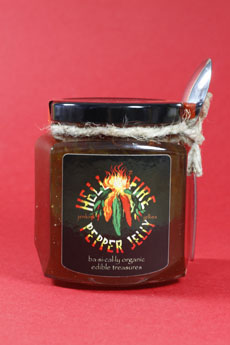PRODUCT: Hellfire Pepper Jelly, Cream Cheese & More
|
We love a good pepper jelly—and not all of them are good. Many are just too sugary, throwing the sweet/heat balance way over to the sweet side.
In eight years of reviewing specialty foods, the only pepper jelly lines we’ve liked enough to review are Aloha From Oregon, Cherith Valley and Diane’s Sweet Heat. And now, there’s Hellfire Pepper Jelly—not a line of pepper jellies, but just one variety in the Jenkins Jellies line. The website can be a bit hyperbolic (e.g. the jelly does not contain “psychotically hot peppers”) but perhaps that’s because one of the company’s owners is related to a famous Hollywood family: actors Blythe Danner and her daughter Gwyneth Paltrow; directors Bruce Paltrow (husband to Blythe) and son Jake Paltrow (among other family members in show biz). Hillary Danner began making jams and jellies from the bounty of the fruit trees and grape arbor in her Los Angeles backyard. She began to sell her most acclaimed recipe, the hot and spicy Hellfire Pepper Jelly, at farmers markets. Demand exploded, and Danner partnered with Maria Newman and chef Jared Levy to create a line of artisan jams and jellies (we wish we had access to the rest of them!). |
 Tasty and hot gourmet pepper jelly, Photo by Elvira Kalviste | THE NIBBLE. |
|
|
Hellfire Pepper Jelly is a very fine example of the genre. The complex flavor comes from a mix of seven different chiles (sorry, we can’t bear to call them “peppers” because of a mistake* made 520 years ago by Christopher Columbus). Buy it on the company website. A portion of sales goes to the Bruce Paltrow Oral Cancer Fund. What Is Pepper Jelly? Pepper jelly is a clear, sweet-and-spicy jelly that contains flecks of hot chile peppers. Different fruits and spices can be added for complexity—for example, pineapple or mango on the sweet side, and tomato or bell pepper on the savory side. Pepper jelly is often made with jalapeños and serranos, which are medium-heat chiles. Habañero is one step up on the Scoville Scale, and Scotch bonnet is at the top of the scale, categorized as extreme. (See the different types of chiles.) While on the hotter side, Hellfire Pepper Jelly does not cripple your taste buds. It’s exhilarating rather than searing. Bring some Hellfire as a host/hostess gift for Halloween, or keep it in mind for teacher gifts, stocking stuffers and other small holiday gifts. How To Use Pepper Jelly You don’t need to have a party to serve it: We enjoy pepper jelly with peanut butter or cream cheese on whole wheat toast. But don’t stop there: Here are dozens of uses with everything from omelets and yogurt to meatballs and cheesecake. |
||


